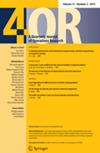Analysis of the sample preparation methods based on piecewise variation coefficients of component mass fractions
IF 2.6
4区 管理学
Q3 OPERATIONS RESEARCH & MANAGEMENT SCIENCE
引用次数: 0
Abstract
Sample preparation methods are usually developed following respective recommendations of the applicable sampling standards. Modern sampling theories allow designing and optimizing these methods. Random errors in sample preparation are calculated based on a theoretical description of the piecewise heterogeneity of the sample obtained using the formulas for the fundamental sampling error. The concept of a piecewise coefficient of variation is introduced and used to develop a formula for the relative error of the sample preparation method. Using a method compiled in accordance with GOST 14180-80 for copper ore as an example, the relative error is established for the preparation of an ore sample with the copper mass fraction of 1.3 %. It is shown that a change in the final preparation size from 0.1 to 0.08 mm affects the error only insignificantly, and sample size changes by stages allow designing a preparation method with the smallest error. It is advisable to analyze the method compiled and change its parameters on the basis of a structural assessment of the influence of individual preparation stages on the error. Sample preparation examples for copper and gold-bearing ore are used to demonstrate the analysis procedure and the parameter changes. Traditionally, the minimum sample masses are established for all stages based on the volumetric heterogeneity of the sample being tested and the size of the sample material. The minimum masses should be found depending on the grain size of the valuable mineral in the ore, the permissible relative error for the size reduction, and the material size for the sample reduced by a factor of 1.5 for nonferrous metal ores.基于组分质量分数分段变异系数的样品制备方法分析
样品制备方法通常是根据相应的适用取样标准的建议制定的。现代抽样理论允许设计和优化这些方法。根据基本抽样误差公式对样品的分段非均匀性进行理论描述,计算样品制备中的随机误差。引入分段变异系数的概念,推导出样品制备方法相对误差的计算公式。以铜矿石GOST 14180-80编制的方法为例,建立了铜质量分数为1.3%的矿石样品制备的相对误差。结果表明,最终制备尺寸在0.1 ~ 0.08 mm范围内的变化对误差影响不显著,样品尺寸随阶段的变化可以设计出误差最小的制备方法。建议对编制的方法进行分析,并在对各个编制阶段对误差影响进行结构性评估的基础上改变其参数。以含铜和含金矿石为例,说明了分析过程和参数的变化。传统上,根据被测样品的体积非均质性和样品材料的大小,为所有阶段确定最小样品质量。最小质量应根据矿石中有价值矿物的粒度、尺寸减小的允许相对误差和有色金属矿石样品的材料尺寸减小1.5倍来确定。
本文章由计算机程序翻译,如有差异,请以英文原文为准。
求助全文
约1分钟内获得全文
求助全文
来源期刊

4or-A Quarterly Journal of Operations Research
管理科学-运筹学与管理科学
CiteScore
3.80
自引率
5.00%
发文量
26
审稿时长
6 months
期刊介绍:
4OR - A Quarterly Journal of Operations Research is jointly published by the Belgian, French and Italian Operations Research Societies. It publishes high quality scientific papers on the theory and applications of Operations Research. It is distributed to all individual members of the participating societies.
 求助内容:
求助内容: 应助结果提醒方式:
应助结果提醒方式:


